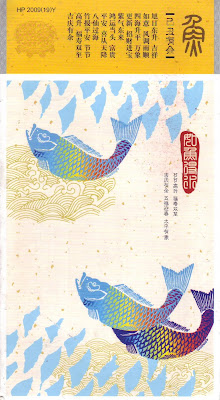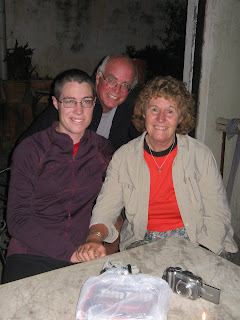
The wind stopped as we quickly dropped in altitude but the trail continued down and down and down and down some more. One long section was a thin rocky trail down steep ridges, precarious drops on all sides. My feet started a quiet ache that became more and more vociferous the longer we kept up our downward way.
It was with bruised toes and great relief that we finally came a suspension bridge atop a ridge looking down upon Muktinath, our camp for the night. The valley was painted in autumn colors, with red leaves drifting in the breeze and prayer flags flapping in the wind.
I thought that we might feel let down after the great crossing of the pass, but the beauty of the valley kept my spirits high. The next day we took an easy and level stroll down to the next town, through apple orchards, stopping for tea in tiny stone villages, stepping over streams and strolling in the sunshine.
When arriving in a town at the end of the day, we usually go past the first few hotels and guesthouses and settle somewhere in the middle of town. When we arrived in Kagbeni, we strolled past what seemed to be the main tourist area, past the Yak Donalds, until the only hotel left was a place up many stairs called the Red House.

Our room was up more stairs, across an inner courtyard crisscrossed with bridges and stairways, and across an open space of roof where apples were drying. From the roof, we could see up the open river valley to the Mustang Valley – an area where trekking permits cost from $500 - $700 and therefore is a mysterious and hardly traveled place.
In the morning, on my way to breakfast, I surprised two sisters cleaning the old wooden floors. One girl sat on a pile of blankets while her sister pulled her around, polishing the floors amidst much laughter. After breakfast, our host asked as, “Would you like to see my shrine?” We were expecting a small family worship place, but the man drew aside a tapestry and opened a hidden door.
Inside was a narrow room with a high ceiling and a beautiful golden Buddha statue inside. It was over 500 years old, mysterious and beautiful.
From that day on, though, time sped forward, every day bringing us closer and closer to leaving the mountains. We entered apple country, where apple cider, apple juice, dried apples and the most amazing apple crumble were all cheap and delicious. More and more trekkers appeared on the trail. A road was being built so that we often had to pull over to the side of the gravel trail and let jeeps pass in clouds of dust. One morning we picked up a local woman walking to the next town looking for company and walked together for a while. We stayed one night in an extremely strange guesthouse which cost about 50cents a night and looked like it hadn’t seen a guest in the last twenty years.

We stayed one night in stone bungalow in a garden full of orange trees. At the end of the garden was a set of stairs leading down to a natural hot springs where we gladly soaked our tired muscles for the rest of the afternoon, taking advantage of happy hour beers and popcorn for the first time in weeks.
Two days later, we were walking uphill for the first time in days. It felt as if we spent all day walking uphill. In the morning at 5am, we woke early and kept climbing, to catch the sunrise from the top of Poon Hill with hundreds of other hikers gathered for the same spectacle.
From there we had planned to head into the mountain range we had spent the last two weeks circling, into the Annapurna Sanctuary. We had the choice between continuing our trek in that direction, or heading back to civilization and exploring the ancient temples of the Kathmandu Valley. Unfortunately, Dengue Fever robbed us of the ability to do both. We opted for civilization, our desire for steak weighing heavily in on our choice.

It seemed like almost a moment later that we were climbing down thousands and thousands of stone steps, back through rice terraces and flowering orchards and down into river valleys. Villages came closer and closer together. The final descent seemed to go on forever. There were steps and more steps and even more steps. Then, in no time, the steps were over, we were in a village, walking along a ride, waiting for a bus, throwing our bags on top and speeding off into the distance.
From our vantage point on top of the bus, we could see the mountain peaks we had become so familiar with vanishing into the sunset, the red peaks glowing brilliantly at the end of the day and then fading into the darkness.
We were out of the mountains.
We spent a few days in Pokhara recuperating. We slept a lot and ate even more and spent a whole day renting a boat and drifting around a lake searching the shores for a monkey population we never sighted. I lay back and read a book while Jay paddled us slowly along the shore but I watched the sun in the leaves more than the pages before me.
When I think of historic places, I am conditioned to think always of Europe, which for North Americans, has so much more history than our newborn cities. I forget just how ancient the civilizations of Asia are and how rich their history, which I never really learned anything about in school.
What I loved most about the places we visited was how alive they were. I am used to history preserved behind glass, not the kind that weary porters rest their packs on and morning vendors stop at in prayer. We climbed the steps of ancient temples and watched prayers and devotions at crumbling shrines through the morning mist. There was no separation between the past and the present, the two lived dynamically intertwined.

One day we took a bus to a city just an hour from Kathmandu, Baktapur. Because we took a local bus, quite by accident, we missed going through the tourist entry to the ancient city, where there is a $15 entry fee. We had no idea this was the case until we were talking to other tourists much later in Kathmandu. Because the fee is so high, many tourists don’t visit and we had the place mostly to ourselves. Those who do visit, generally go back to the capital to spend the night, so we had trouble finding reasonably priced accommodation. We did find an amazing local restaurant (Mini Momo Max) with ridiculously cheap and delicious food (and only two tables) as well as the local specialty, home made yogurt. Known as “curd” and served in clay bowls, the Baktapur yogurt was the thickest, richest, creamiest yogurt I have ever tasted.
We walked through Kathmandu one day, crossed the sacred river, which was a black oozing field littered with garbage and exuding a great stench, to climb the many steps to Bodhinath, one of the city’s holiest temples. It was full of tourists and touts and stalls selling trinkets and monkeys.
I sat with my back against one of the temple buildings enjoying the sun and the view down upon the city and the great birds circling in the updrafts, watching Jay take photos. All of a sudden, a group of monkeys appeared in the area, moving purposefully across the paving stones. They reached the far side and swung up on the railing, then started moving along it. The first monkey reached a young boy who was sitting up against the railing enjoying the view with his family. The monkey grabbed the boy’s shoulder and started shaking him, then jumped off into the jungle. The second monkey grabbed the boy’s shoulder and started biting into it. The parents just stood there a little shocked. Then, in an instant, all the monkeys had vanished and the boy was crying.
Another day we went out to Bodhinath, a very holy place just outside Kathmandu where a large Tibetan community live. Bodhinath is a large white stupa which to me, compared with the crumbling brick temples we had been visiting, had very little architectural poetry to it. The real magic of the place is evident at sunrise and sunset.

Near the end of the day, hundreds of people come to the stupa and walk around it, all traveling clockwise. There is a path around the stupa and the stupa wall is lined with prayer wheels. Some people turn them as they walk, others count prayer beads. The truly devout practice prostrations as they travel around. The prostration includes an upwards salutation, then spreading your body entirely prostrate upon the ground and rising to repeat. Some people take three steps between every prostration, others only one.
During the day, there are people walking around the building, and some practicing prostrations inside, but at night there are hundreds and hundreds of people participating. Some are deep in thought and prayer, others walk with family and friends, talking and laughing. In the morning, there are boys and girls in school uniforms on their way to school, walking in circles for a while before going to catch their bus. Many of the older women were in traditional Tibetan dress.
In the misty morning, my feet making circles around the stupa with hundreds of others, I pause to buy fresh, hot, yeasty Tibetan bread from a vendor. At night, we walk amidst the glow of hundreds of butter lamps.
Another day, we walk a few kilometers to a famous Hindu holy site, Pashupatinath.This is the place where devout Hindis most wish to be cremated. We watched a pyre burn by the water and the family bathing in the river. We wandered amid ruins and watched monkeys feed in a frenzy in the forest.

In the morning, we had trouble getting back to the city. All the taxis wanted a high price and the busses weren’t running. There was a riot, we were told. We eventually shared a cab with some other people and got back to our hotel, walking past paving stones left in the middle of the street where the day before they had been thrown at riot police. A picture in the paper the next day showed the same road with tires burning. A general strike had been called for the day and all the shops were closed. The touts were off the street and everything was empty and strangely deserted.
But gradually through the day, a few shops opened and by the following day we had no trouble finding a taxi and making our way to the airport. Almost before we knew it, we were in the air, watching Everest fly by outside the window, streaking across the sky back to Thailand. After five weeks of traveling, we were both ready to head home.
















































